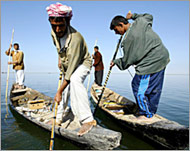Iraqi marshes revive
Wetlands that once sheltered communities and a host of wildlife in southern Iraq are being partly restored and could offer a haven once again, experts have said.

Water coming into the area from the Tigris and Euphrates rivers is unexpectedly clean, washing away toxic salts that built up when the area was drained during Saddam Hussein’s rule, the international team of experts said on Saturday.
Bird species are starting to return, including pelicans, cormorants and wading birds. The area was also important for spawning fish and shrimp and, but with only 20% of the marshes restored, these animals still have a long way to go, the experts said.
Garden of Eden
“The future of the 5000-year-old Marsh Arab culture and the economic stability of large portions of southern Iraq are dependent on the success of this restoration effort,” they write in next week’s issue of the journal Science.
 |
|
The marshes could return with |
The area of tall reeds and clear waters is valued by more than just its immediate inhabitants.
“The Mesopotamiam marshes of southern Iraq are considered by many to be the cradle of Western civilisation and are often referred to as the Garden of Eden,” anthropologist Peter Reiss, scientist Curtis Richardson and their colleagues wrote.
“Notably, the marshes were once the permanent habitat for millions of birds and a flyway for millions more migrating between Siberia and Africa.”
Marsh revived
Richardson said soon after the US invasion of Iraq, farmers blew up dikes and earthen dams that had held the water back. Often this had unexpected effects.
“You’d go to a village and find it half-flooded. They had no idea it would go that far,” Richardson said. “You may be washing salt into another farmer’s field.”
Ecologists were worried that toxic salts, pesticides and other chemicals could be washed back into the marshes and kill off what life had managed to survive. But except for some areas that are saltier than normal, they have found little evidence this happened.
While rainfall is only about four inches a year, the snowmelt in the mountains of neighboring Iran and Turkey send clear, fresh water every spring, they found.
Reiss estimated 100,000 to 125,000 people remain in the area, but of the 75,000 his team surveyed, all had been displaced at least once and some as many as 18 times.
“They are not expecting a full return and revival to what the marshes looked like,” he said. “In fact, they don’t want it.”